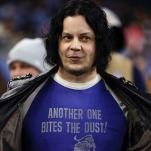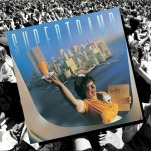The magazine also ran an article in 1962 by researcher William O. Davis, claiming according to Dean’s Fourth Law Of Motion, a device like Dean’s could use “gravitational-inertial radiation” to separate Newton’s action and reaction. But Dean was secretive about how the device actually worked, and refused to subject it to a test that would prove that it was successful. (The test involved a pendulum, but beyond that the details aren’t made clear here.)
Strangest fact: That Dean wanted to get paid may not be a surprise, but how he wanted to get paid might be. Both 3M and an unnamed aerospace company expressed an interest in Dean’s drive. He refused to even demonstrate the thing without not only being paid in advance, but being awarded the Nobel Prize in advance. Neither company took him up on it, and we can only assume the Nobel committee had a good chuckle. The aerospace company (and presumably 3M as well) were pretty quickly convinced that the device never worked in the first place.
Thing we were happiest to learn: Dean did at least get some of his ideas patented. In 1959, he was granted a patent for a “system for converting rotary motion into unidirectional motion,” and six years later he patented a “variable oscillator system.” Together, they do not make a Dean drive, and neither Dean’s patents or more than 50 similar ones that followed were able to produce reactionless energy. As late as 2006, NASA was still getting proposals for variations on the “oscillation thruster,” and eventually released a memo stating that future submissions must “meet minimal thresholds of proof before engaging in further correspondence.”
To date, only one scientist has successfully built a working oscillation overthruster. A documentary about his efforts, Buckaroo Banzai Across The 8th Dimension, is available on several streaming services.
Thing we were unhappiest to learn: As you may have already surmised, there never was a working Dean drive. After Dean’s death in 1972, not only was nothing resembling a working drive found among his effects, even the models he used for the few small-scale demonstrations he had made were nowhere to be found, and he left behind no designs. Wikipedia charitably says that without Dean’s designs, it’s impossible to “see if they worked as he claimed,” but let’s face it, we already know the answer to that question. The best analysis of Dean’s demonstrations have concluded that the device merely vibrated against the surface it was placed on, moving in one direction like the classic “toothbrush robot” kid science project, and certainly not the motion in a vacuum Dean claimed.
Best link to elsewhere on Wikipedia: One of John W. Campbell’s other pet projects to promote was the Hieronymus Machine, the creation of pseudoscientist Thomas Galen Hieronymus. The machine used a rotating prism to detect “eloptic” radiation, an energy that Hieronymus seems to have also invented, which was supposedly emitted by all matter (much like the Force), and exhibited some of the qualities of both light and electricity. The user of Hieronymus’ device would supposedly feel a tingling when eloptic energy was detected. (Eloptic radiation has not been detected by any reputable scientist.)
Further Down the Wormhole: Another sci-fi writer who weighed in on Dean’s device was Jerry Pournelle, who opined that G. Harry Stine, one of the researchers who witnessed Dean’s demonstration of his device, was well-qualified to assess the device but was also “more gullible than other persons.” While Pournelle wasn’t an avowed racist like Campbell, he described his politics as “to the right of Genghis Khan,” and is suspected to have ghostwritten the section of Ronald Reagan’s 1983 speech that outlined the “Star Wars” Strategic Defense Initiative. However, Pournelle clashed with neoconservatives, opposing both Iraq Wars, and insisting the money we were pouring into warfare should have been used to achieve energy independence.
While the neocons’ peak influence occurred in the George W. Bush administration—when they pushed for aggressive military intervention in Iraq and elsewhere—the movement began as a strange-bedfellows alliance between conservative hawks, and moderate socialists disillusioned with the McGovern-era Democratic party. One of the unlikeliest early neocons was Bayard Rustin, a lifelong civil rights activist who began organizing Freedom Rides as early as the 1940s, was a key ally of Martin Luther King in the ’60s who had to work largely behind the scenes because he was gay, but then became a voice in the gay rights movement in the ’80s. We’ll look at his life devoted to social justice next week.







![Rob Reiner's son booked for murder amid homicide investigation [Updated]](https://img.pastemagazine.com/wp-content/avuploads/2025/12/15131025/MixCollage-15-Dec-2025-01-10-PM-9121.jpg)

























![HBO teases new Euphoria, Larry David, and much more in 2026 sizzle reel [Updated]](https://img.pastemagazine.com/wp-content/avuploads/2025/12/12100344/MixCollage-12-Dec-2025-09-56-AM-9137.jpg)







